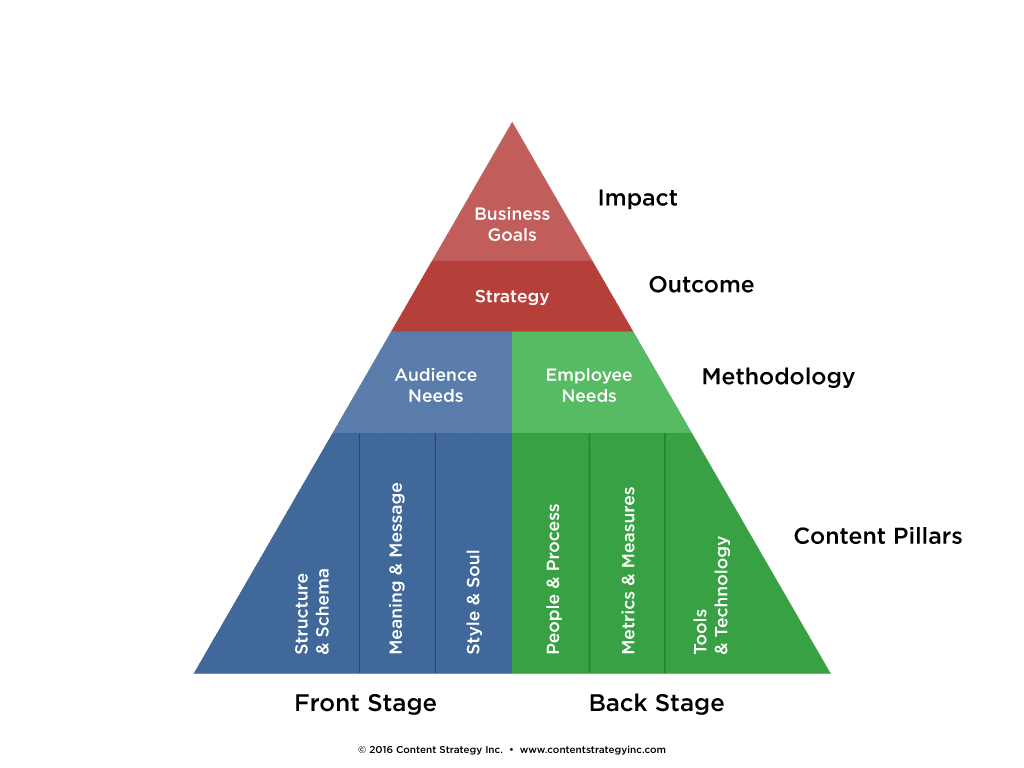Content strategy is confusing
If you search online to figure out what content strategy is, be prepared to be confused.
There are experts who define content strategy (many of them in fact) but their definitions are rarely in plain language and the number of variations and contradictions are overwhelming and confusing.
Some people have come up with models to show what their version of content strategy looks like. Some of them are quite good, and easier to grasp than written definitions. But none of them have done a great job of showing the breadth and impact of content strategy within a simple, memorable framework that is easily understood by people outside of our industry.
So, we took that on as a challenge
Keeping our clients top of mind, we set out to create a new model for content strategy that:
- Shows the different aspects of content strategy
- Emphasizes the holistic nature of content strategy
- Points to the impact of content strategy
- Doesn’t use industry jargon
- Is applicable in different situations
- Is helpful to our clients
- Has a simple, memorable framework
Over a period of six months, our team brainstormed, collaborated, challenged each other, lost sleep, and had multiple “Eureka!” moments, many of which lasted only a few seconds before fading back into frustration. It seemed like an impossible task at times, but I think we finally pulled it off.
The new content strategy model
This content strategy model shows that content strategy is business driven and audience focused. All activities drive towards business impact, and the content strategy itself connects audience needs with specific business goals. It also shows that content strategy creates an experience for your audience (front stage) and also takes place behind the scenes in ways that your audience never sees (back stage).
But the critical foundation of an effective and sustainable content strategy lies in understanding and shaping six essential content pillars. If any pillar is missing or underdeveloped, your content strategy will falter.
Front-stage content pillars
- Structure & schema. This is how the content is organized and structured as components, on the page, throughout a website, and across all content channels. It’s an essential part of creating content that’s easy to find and easy to use.
- Meaning & message. This is what you’re communicating to your audience. It’s what they come for (topics) and what they take away (messages, both explicit and implicit).
- Style & soul. This is how you’re communicating. It’s your brand and personality and includes things like writing style, tone, and voice. It shows who you are.
Back-stage content pillars
- People & process. This is who does the work and how they do it. It includes things like team structures, roles and responsibilities, skill sets, and processes. Basically, anything to do with how people get work done.
- Metrics & measures: This refers to how content success is measured, and how effective the content practices are. It includes qualitative and quantitative metrics aligned to both audience needs and business goals.
- Tools & technology: These are the support systems that help content contributors to do their jobs well. It includes technologies such as content management systems, communication tools, and databases as well as support materials such as style guides, editorial calendars, and decision trees.
Were we successful?
I think we nailed each of the challenges we set for ourselves as we were creating this new content strategy model. But, we aren’t the judge – you are. Does this model help you to see how content strategy drives towards business goals? Do you see how the different pillars of content strategy are interconnected, and how each of them are essential?
We’d love to hear your thoughts. Please find us on LinkedIn or Twitter, or send me an email at kathy@contentstrategyinc.com.
Further reading
The content strategy conversation is skewed and that’s a problem
